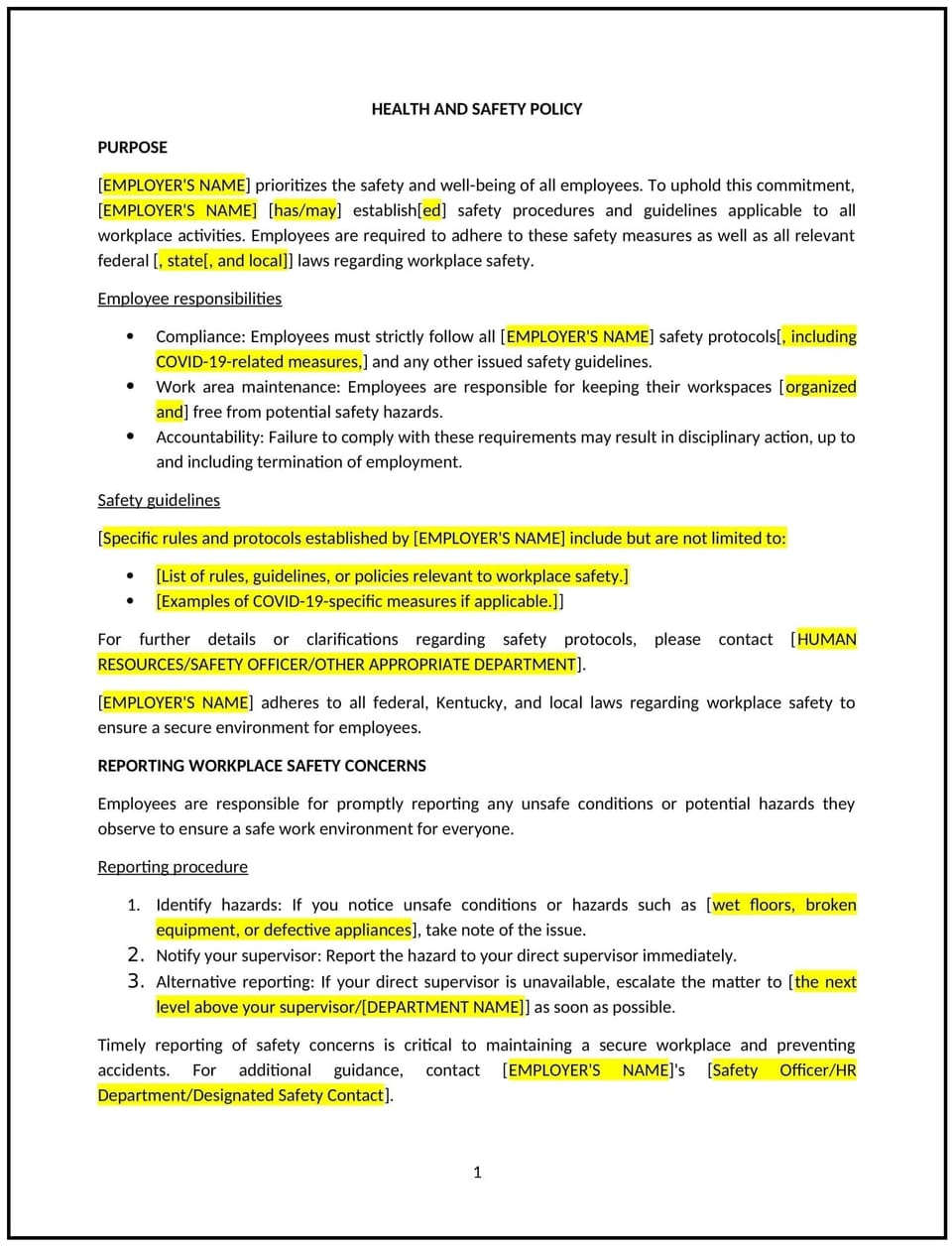Health and safety policy (Kentucky): Free template

Health and safety policy (Kentucky)
A health and safety policy outlines the responsibilities and procedures that Kentucky businesses follow to maintain a safe and healthy work environment for all employees. This policy supports compliance with state and federal regulations, promotes a culture of safety, and minimizes risks associated with workplace hazards.
By adopting this policy, businesses can reduce workplace injuries, improve employee well-being, and promote a productive work environment.
How to use this health and safety policy (Kentucky)
- Define health and safety objectives: Clearly outline the business’s commitment to maintaining a safe workplace, identifying potential hazards, and minimizing risks to employees.
- Identify potential hazards: List common hazards in the workplace, such as physical, chemical, biological, ergonomic, and environmental risks, and explain how they will be mitigated.
- Establish safety procedures: Provide detailed instructions on how employees should handle specific hazards or emergency situations, such as fires, chemical spills, or workplace accidents.
- Assign responsibilities: Specify who is responsible for maintaining health and safety standards, including managers, safety officers, and employees.
- Provide training: Ensure that employees receive regular training on safety protocols, equipment handling, emergency procedures, and reporting hazards.
- Conduct regular safety audits: Establish procedures for regularly assessing workplace safety, identifying potential risks, and implementing improvements.
- Report and investigate incidents: Outline the process for reporting workplace accidents, injuries, or safety concerns, and detail how the business will investigate incidents to prevent recurrence.
Benefits of using this health and safety policy (Kentucky)
This policy provides several key benefits for Kentucky businesses:
- Reduces workplace injuries: Helps prevent accidents by identifying and addressing potential hazards and providing employees with the tools and knowledge to stay safe.
- Promotes employee well-being: Ensures that employees have a safe work environment, which can improve overall job satisfaction and reduce absenteeism.
- Complies with legal requirements: Aligns with Kentucky state laws and federal regulations, such as OSHA guidelines, to reduce the risk of legal penalties or lawsuits.
- Enhances productivity: A safe work environment minimizes disruptions and encourages employees to focus on their tasks without concern for their health or safety.
- Builds a positive company culture: Demonstrates the business’s commitment to employee care, fostering a sense of trust and respect between the employer and employees.
Tips for using this health and safety policy (Kentucky)
- Communicate the policy: Ensure all employees are aware of the health and safety policy by sharing it during onboarding and posting it in visible areas around the workplace.
- Provide ongoing training: Conduct regular safety training sessions to reinforce safe practices and keep employees informed of new procedures or regulations.
- Monitor safety performance: Regularly assess how well safety protocols are being followed and make necessary adjustments based on incidents or audits.
- Foster employee involvement: Encourage employees to participate in safety committees, report hazards, and suggest improvements to safety practices.
- Review periodically: Update the policy to reflect any changes in workplace conditions, Kentucky state laws, or federal regulations.
Q: What is the purpose of a health and safety policy?
A: The policy sets clear guidelines for maintaining a safe and healthy work environment, ensuring employees are protected from risks and hazards in the workplace.
Q: What types of hazards are addressed under this policy?
A: The policy addresses physical, chemical, biological, ergonomic, and environmental hazards that may be present in the workplace.
Q: Who is responsible for ensuring workplace safety?
A: The business should assign specific roles to managers, safety officers, and employees, each with defined responsibilities for maintaining safety standards.
Q: How should employees report health and safety concerns?
A: Employees should report concerns or incidents to their manager, HR, or designated safety officer according to the procedure outlined in the policy.
Q: How often should health and safety training be conducted?
A: The policy should specify that safety training is conducted regularly, at least annually, or more frequently if new risks or procedures are introduced.
Q: What happens if an employee does not follow safety protocols?
A: The policy should outline the disciplinary actions that may result from non-compliance, ranging from verbal warnings to termination, depending on the severity of the violation.
Q: How often should the health and safety policy be reviewed?
A: The policy should be reviewed periodically, at least annually, to ensure it is up-to-date with Kentucky laws, federal regulations, and current workplace conditions.
This article contains general legal information and does not contain legal advice. Cobrief is not a law firm or a substitute for an attorney or law firm. The law is complex and changes often. For legal advice, please ask a lawyer.


